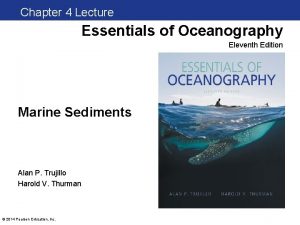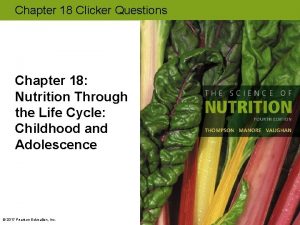Chapter 17 Clicker Questions Chapter 17 Nutrition Through





















- Slides: 21

Chapter 17 Clicker Questions Chapter 17: Nutrition Through the Life Cycle: Pregnancy and the First Year of Life © 2017 Pearson Education, Inc.

Folate deficiency in the first weeks after conception has been linked with an increased risk for which of the following problems in the newborn? a) b) c) d) FASD neural tube defects large for gestational age all of the above © 2017 Pearson Education, Inc.

Folate deficiency in the first weeks after conception has been linked with an increased risk for which of the following problems in the newborn? a) b) c) d) FASD neural tube defects large for gestational age all of the above © 2017 Pearson Education, Inc.

The period of pregnancy during which Calorie needs are highest to support fetal growth is a) the embryonic period (conception through week 8). b) the first 5 weeks of the fetal period (weeks 9 through 13). c) the second trimester. d) the third trimester. © 2017 Pearson Education, Inc.

The period of pregnancy during which Calorie needs are highest to support fetal growth is a) the embryonic period (conception through week 8). b) the first 5 weeks of the fetal period (weeks 9 through 13). c) the second trimester. d) the third trimester. © 2017 Pearson Education, Inc.

A pregnancy weight gain of 28 to 40 lb is recommended for a) all women. b) women who begin their pregnancy underweight. c) women who begin their pregnancy at a normal weight. d) women who begin their pregnancy overweight or obese. © 2017 Pearson Education, Inc.

A pregnancy weight gain of 28 to 40 lb is recommended for a) all women. b) women who begin their pregnancy underweight. c) women who begin their pregnancy at a normal weight. d) women who begin their pregnancy overweight or obese. © 2017 Pearson Education, Inc.

The RDA for pregnant women is increased over the RDA for nonpregnant women for a) b) c) d) protein vitamin D calcium all of the above © 2017 Pearson Education, Inc.

The RDA for pregnant women is increased over the RDA for nonpregnant women for a) b) c) d) protein vitamin D calcium all of the above © 2017 Pearson Education, Inc.

Preeclampsia is a) likely to be diagnosed in a pregnant woman with high blood pressure but no other signs or symptoms. b) a medical emergency characterized by seizures and kidney failure. c) more common in overweight and obese women compared to women of normal weight. d) managed by exercise and a reduced Calorie diet. © 2017 Pearson Education, Inc.

Preeclampsia is a) likely to be diagnosed in a pregnant woman with high blood pressure but no other signs or symptoms. b) a medical emergency characterized by seizures and kidney failure. c) more common in overweight and obese women compared to women of normal weight. d) managed by exercise and a reduced Calorie diet. © 2017 Pearson Education, Inc.

Which of the following is considered safe for most pregnant women? a) exercise b) drinking no more than two cups of brewed coffee a day c) using the artificial sweetener saccharin in moderation d) none of the above © 2017 Pearson Education, Inc.

Which of the following is considered safe for most pregnant women? a) exercise b) drinking no more than two cups of brewed coffee a day c) using the artificial sweetener saccharin in moderation d) none of the above © 2017 Pearson Education, Inc.

Which of the following hormones is responsible for the let-down response? a) b) c) d) progesterone estrogen oxytocin prolactin © 2017 Pearson Education, Inc.

Which of the following hormones is responsible for the let-down response? a) b) c) d) progesterone estrogen oxytocin prolactin © 2017 Pearson Education, Inc.

Which of the following is an advantage of breastfeeding? a) Breastfeeding boosts fertility. b) Breast milk provides all of the nourishment an infant needs for the first year of life. c) Breastfeeding can help the mother more easily lose the weight she gained during pregnancy. d) All of the above are advantages of breastfeeding. © 2017 Pearson Education, Inc.

Which of the following is an advantage of breastfeeding? a) Breastfeeding boosts fertility. b) Breast milk provides all of the nourishment an infant needs for the first year of life. c) Breastfeeding can help the mother more easily lose the weight she gained during pregnancy. d) All of the above are advantages of breastfeeding. © 2017 Pearson Education, Inc.

Which of the following nutrients should be added to the diet of breast-fed infants when they are around 6 months of age? a) b) c) d) the fatty acids AA and DHA vitamin K vitamin D iron © 2017 Pearson Education, Inc.

Which of the following nutrients should be added to the diet of breast-fed infants when they are around 6 months of age? a) b) c) d) the fatty acids AA and DHA vitamin K vitamin D iron © 2017 Pearson Education, Inc.

Which of the following would be the most appropriate food to offer an infant who is 9 months old? a) b) c) d) Cream of Wheat cereal whole cow's milk small fruits such as grapes and raisins puréed peas © 2017 Pearson Education, Inc.

Which of the following would be the most appropriate food to offer an infant who is 9 months old? a) b) c) d) Cream of Wheat cereal whole cow's milk small fruits such as grapes and raisins puréed peas © 2017 Pearson Education, Inc.
 Clicker questions physics
Clicker questions physics Math clicker
Math clicker E clicker
E clicker +audience +response +clicker
+audience +response +clicker Lesson 5 building an app clicker game
Lesson 5 building an app clicker game Earth clicker
Earth clicker Maximal heart rate
Maximal heart rate Japan movie rape
Japan movie rape Clicker stop motion
Clicker stop motion Cooi clicker
Cooi clicker Umbc clicker
Umbc clicker Clicker box
Clicker box Roger rabbit
Roger rabbit Clicker stop motion
Clicker stop motion Clicker
Clicker Phys 172
Phys 172 Buzka clicker
Buzka clicker Salt clicker
Salt clicker Clicker gravel transport
Clicker gravel transport Atomic clicker
Atomic clicker Spacebar click
Spacebar click Fibonacci clicker
Fibonacci clicker







































